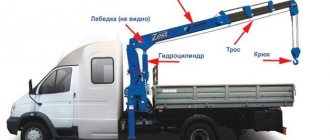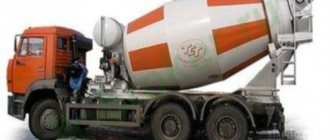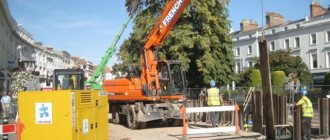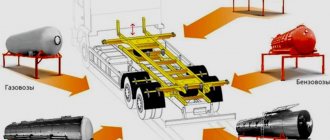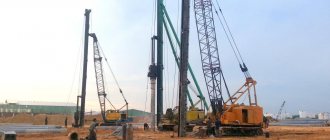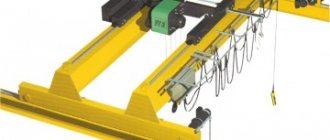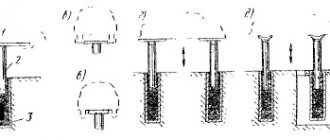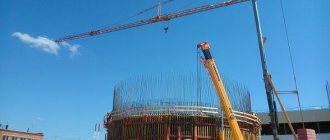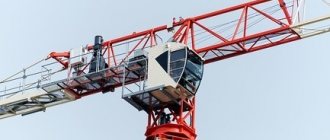Mobile cranes are included in the group of self-propelled shooting cranes and are the most common among all representatives of this group.
The cranes are assembled on truck chassis and are installed at the front and rear outriggers. This makes the truck cranes stable when the truck crane is working with loads and increases the lifting capacity. Such cranes have the ability to move independently on the ground and overcome inclines within 20 degrees.
Truck cranes are very mobile, thanks to which they quickly move to various work points located at a distance from each other. Rail transportation does not require dismantling the cranes, since they do not exceed the dimensions of railway transport.
Working equipment
The main equipment is represented by working booms. Replaceable are extension or retractable sections on those truck cranes that are equipped with two types of booms - telescopic and jib.
A pulley block, the functional task of which is to raise and lower the boom, belongs to the boom equipment.
Truck cranes are equipped with the following equipment for lifting loads:
- a hook clip used to capture piece goods;
- grab for bulk cargo.
Purpose of truck cranes
Mobile, maneuverable self-propelled machines with a boom lifting module are designed for loading and unloading and installation work. With their help, large loads are processed, pipelines are installed, foundations, walls, and ceilings are erected. In off-road conditions, an all-terrain truck crane with wheels of increased width and enhanced driving capabilities is indispensable. The help of such equipment is especially valuable when installing gas and oil pipelines that are laid across rough terrain, in the forest, in the steppe.
Drive device
Based on the type of drive, truck cranes are divided into two types:
- single-engine: the mechanisms are driven by the chassis engine;
- multi-motor: each mechanism is driven by its own engine.
The drive can be one of three:
- Mechanical. This type is a connection of the power unit with the power take-off, gearbox and power rope drums.
- Electric. So named because of the presence of a generator that supplies electric current to the engine.
General view of the K-2.5-19 crane: 1 - car frame; 2 — fixed frame of the crane; 3 — rotating support; 4 — rotating frame; 5 — outriggers; 6 — mechanism hood; 7 — load lifting mechanism; 8 — jib winch; 9 — fixed block of the jib pulley; 10 — cabin; 11 - headlight; 12 — rotation mechanism; 13 - generator; 14 — oil tank of the outrigger hydraulic system; 15 — spare wheel; 16 — boom support; 17 — grab damper; 18 - boom; 19 — traverse with block; 20 — limit switch lever; 21 — clip with hook; 22 — hook brace
- Hydraulic. In addition to the power take-off, hydraulic pumps, hydraulic motors and hydraulic cylinders are attached to the power plant. Very compact.
Hydraulic driven truck crane
Automotive cranes: types, design, characteristics
Truck crane (automobile crane) is a self-propelled jib-type crane mounted on a serial or special automobile chassis. Truck cranes are used to perform loading and unloading, construction and installation work, lifting and lowering loads, moving loads in a horizontal plane over short distances.
General structure of a truck crane
The truck crane consists of two parts:
- Wheeled chassis;
- Crane equipment.
The chassis can be a two-, three-, or four-axle production vehicle that has undergone minimal modernization (type KA). Also, cranes can be installed on a specially designed automobile-type chassis (KSh type), such cranes have high and very high lifting capacity.
Crane equipment includes a rotating platform with a boom, a drive, a cabin or control station, outriggers (outriggers, mounted on the chassis) and various auxiliary elements.
Classification of truck cranes
All truck cranes are jib cranes - their load-handling member is suspended from a rotating boom. Crane equipment can be equipped with booms of various design types:
- Cantilever truss, beam or combined ones of constant length;
- Telescopic variable length;
- Variable length folding;
- Telescopic or folding with retractable extension or jib.
Currently, truss jib cranes are almost never used; they have been replaced by cranes with telescopic and folding booms. A typical 16 ton or 25 ton truck crane has two or three sections (elbows) and can be equipped with a jib and various automation systems.
According to the method of controlling the boom and lifting mechanisms, cranes are divided into three groups:
- Mechanically driven by chassis engine;
- With hydraulic drive;
- Electrically driven;
- With a combined drive – mechanical and electric;
Mechanically and electrically driven cranes have a rope mechanism for changing the boom length, while in hydraulically driven cranes the boom length is changed by hydraulic cylinders.
Characteristics of truck cranes
The main characteristics of truck cranes include lifting capacity, boom reach and lifting height. Currently, cranes on a standard truck chassis are produced with a lifting capacity of up to 25 tons or more, on special chassis - up to 2000 tons. For example, the largest truck crane in the world was built in China, this is the Zoomlion ZACB01 model on a 12-axle chassis, capable of lifting 2000 tons The boom radius and lifting height of modern cranes lie within a very wide range - from a few to tens of meters, and in some cases - up to a hundred meters.
In the Russian Federation, the production and characteristics of automobile cranes are regulated by GOST 22827-85, GOST 33167-2014, GOST 27555-87 (ISO 4306-1-85), GOST 33166.2-2014 and others. Our country produces truck cranes of the brands “Galichanin”, “Ivanovets”, “Chelyabinets”, the most famous foreign cranes are KATO, Komatsu, Liebherr, Krupp, Terex and others.
Specifications
The truck crane has technical characteristics that differ significantly from each other. Load capacity is provided with the help of outriggers, in this case this indicator increases by 80 percent compared to work with no supports. The crane is controlled from different cabins depending on the situation: the chassis cabin is used to control the crane when moving from place to place, the crane operator’s cabin is used when directly working with a truck crane.
Movement speeds during operation are regulated by the gearbox even at those moments when the rotational frequencies of the power plant shaft change. Sometimes it is possible to move a crane with a light load attached to a hook. The location is the rear wheel sector, the direction is the longitudinal chassis, and the lift height should be within 0.5. The speed of the truck crane must be limited to 5 km/h.
Types of truck crane work
Truck cranes are used to perform a variety of types of work.
A truck crane is capable of performing a variety of types of work related to lifting and reloading lump, packaged or bulk materials. They are actively used by utility and repair services, used in construction, reconstruction of buildings and facilities, during rescue operations, etc.
The main types of truck crane work are as follows:
- laying pipelines and other utility networks;
- loading into open bodies or wagons;
- unloading from open bodies or wagons;
- Men at work;
- installation of block structures;
- lifting construction materials and equipment;
- moving heavy machinery, cars, metal structures.
These are not all types of work for which truck cranes are used. The versatility and multifunctionality of this special equipment make it in demand in various fields.
Boom device
The boom of a truck crane is its main working mechanism, lifting and moving loads. The design and operational characteristics of the boom determine the lifting capacity of the equipment.
Truck cranes are used in a wide range of applications, which requires various design features of the mechanisms to optimally perform the assigned tasks. Such tasks are often associated with the following circumstances:
- bulky or heavy loads;
- difficult terrain;
- difficult to reach conditions;
- cramped conditions in the city.
The main characteristics of the arrow determine the ability to perform certain tasks. It is along the boom that the trolley, which has a load-handling mechanism, moves. The operational capabilities of the crane boom influence how much lifting weight the truck crane can handle. To complete tasks of different difficulty levels, developers produce several variants of arrows.
The first models of truck cranes were equipped with lattice booms. Such booms are secured with a cable suspension. When installing them, the hook and suspension are strengthened with a cable. With a lattice design, the truck crane has the advantage of low weight.
Telescopic booms are currently the most in demand compared to other types. The basis of such booms are retractable segments, making the booms very flexible and able to withstand heavy loads when lifting heavy loads. Domestic industry represents the maximum possible sections of five.
In most cases, it is more convenient to use cranes with tower booms for work. They differ from others by their significant lifting height. This type of equipment is ideal for use in the construction of large structures of great height.
Types of truck cranes by boom length
Modern manufacturers of special equipment are trying to offer the widest range of boom reach for truck cranes in order to make the machines universal and multifunctional. In the light class there are types of truck cranes with a boom length of 6-8 meters. Such miniature and compact machines, however, are widely in demand because they are able to work in limited areas and in densely built-up conditions. The real giants among truck cranes in terms of boom length are super-heavy class machines, their boom reach exceeds 100 m.
There are also special lattice superstructures that allow you to increase the reach of the boom of a truck crane. In this way, it turns out to “build up” 20-30 m, depending on the manufacturer and the specific model of the crane.
The most popular types of truck cranes by boom length:
- “Ivanovets” with a boom of 21-48 m;
- "Galichanin" with a boom of 4-54 m.
Considering the different types of truck cranes, you can see that the length of the boom does not directly depend on the load capacity. Although with increasing tonnage both of these technical characteristics increase. If you try to combine the types of truck cranes by boom length and lifting capacity, you will get the following table:
| Boom length | Load capacity |
| Up to 14 m | 14 t |
| 18-21 m | 18-21 t |
| 28-47 m | 25 t |
| 34-48 m | 50 t |
| 52-71 m | 90-100 t |
| 56-100 m | 120+ t |
Chassis and supporting structure
There are two types of truck crane chassis:
The first type of chassis includes classic trucks (road and high-cross-country). It is on them that the supporting crane frame is located. During operation, the truck frame is not loaded; all the weight falls on the crane frame and hydraulic supports, which are positioned before work. Medium-duty truck cranes are popular in Russia and neighboring countries. For example, this class includes Ivanovets, MAZ, Ural, KamAZ and many other domestically produced models. Sometimes cranes produced in Russia are installed on chassis from foreign manufacturers. A similar scheme is used in Japan, but is mainly used for installing small-tonnage Tadano cranes. In Western countries such a scheme is very rare.
The first type of chassis is equipped with a safety cradle, which is installed near the boom cabin. With this equipment, truck cranes have a significant problem: the driver’s view is blocked by the central hook of the crane.
The second type includes special chassis, which are designed individually for each crane. The scheme is popular in foreign countries for medium- and large-tonnage cranes. Such chassis have increased maneuverability and oversized width.
Operator and slinger work
According to safety regulations, two people are required to operate a truck crane - an operator who sits in the cabin and operates the levers, and a slinger who is outside. It is impossible to do all the work alone. The operator constantly sits in the cab and cannot fully control the situation, so he needs an assistant who will be outside and report to him the necessary information. The main responsibilities of the slinger also include securing the load before lifting it. This is not an easy job, for which you need to take special courses.
Control cabin
There are two types of cabins from which the crane is controlled:
- Stationary. The overall width and height are suitable for its location. This cabin is equipped with a grille that protects against the fall of various objects when working in construction, a sliding door, and panoramic glass.
- Non-fixed tower. In turn, it is divided into two types, sometimes combined. The first type is equipped with a hydraulic mechanism to change the inclined angle as necessary to maximize the possibility of overhead visibility. Another type is sometimes called “rotary”. When the hydraulics change the operating mode to the driving mode, the cabin rotates 180 degrees, ending up behind the counterweight. This is a necessary measure to ensure that the cabin can be folded into its dimensions while driving.
Example of a truck crane control circuit
type of drive
Modern truck cranes are equipped with single- and multi-motor drives. Units with a single-motor drive use the power of one motor to activate the operating mechanisms. Movement is transmitted to other components through a mechanical transmission.
Unlike a single-engine crane, in a multi-motor crane each mechanism is driven by a separate motor. Cranes of this type have less weight, this is their advantage. However, the high cost of power electrical equipment for a multi-motor drive makes it advisable to use such a configuration scheme for cranes with a lifting capacity of 25 tons or more.
Manufacturers
Automotive cranes are manufactured by various companies in different countries.
| Manufacturer | Class | Load capacity min./max., t | A country |
| Ivanovets | Mid-ton truck on a free chassis | from 16 to 80, as well as | Russia |
| Chelyabinsk | from to 50 | ||
| Galician | from to 100 | ||
| KATO | Heavy duty on its own chassis | from 60 to 150 | Japan |
| Komatsu | from 30/ to 00 | ||
| Zoomlion | limit 2000 | China | |
| XCMG | limit 1600 | ||
| Liebherr | All | from 5 to 1200 | Germany, Austria, Switzerland |
| Terex | from 30 to 1200 | USA | |
| Gazpromkran | Mid-ton truck on a free chassis | from 5 to 30 | Russia |
| Grove | Heavy duty on its own chassis | limit 450 | Germany |
| Krupp | limit 200 | ||
| TAKRAF | Railway, truck crane | limit 200 | |
| Tadano | Light and medium free-launching | limit 50 | Japan |
| Lokomo | Medium and heavy on their own chassis | from 20 to 100 | Finland |
Classification of cranes by type of working boom
Crane booms come in several varieties:
- Telescopic - structures with a rigid suspension, consisting of several retractable sections.
- Lattice, equipped with flexible steel cables. More difficult to install, but have greater load capacity.
- Tower. The main boom serves as a support.
- Equipped with a jib - an element that extends the main boom and expands the possibilities of using the equipment.
A truck crane is a fairly expensive mechanism, so often the best way to operate it is to rent it from a specialized company. When choosing, you should focus primarily on the type of boom, its reach and the load capacity of the model. offers modern truck cranes in excellent condition for rent on attractive terms.
